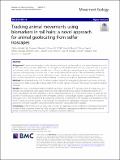| dc.description.abstract | Background
Current animal tracking studies are most often based on the application of external geolocators such as GPS and radio transmitters. While these technologies provide detailed movement data, they are costly to acquire and maintain, which often restricts sample sizes. Furthermore, deploying external geolocators requires physically capturing and recapturing of animals, which poses an additional welfare concern. Natural biomarkers provide an alternative, non-invasive approach for addressing a range of geolocation questions and can, because of relatively low cost, be collected from many individuals thereby broadening the scope for population-wide inference.
Methods
We developed a low-cost, minimally invasive method for distinguishing between local versus non-local movements of cattle using sulfur isotope ratios (δ34S) in cattle tail hair collected in the Greater Serengeti Ecosystem, Tanzania.
Results
We used a Generalized Additive Model to generate a predicted δ34S isoscape across the study area. This isoscape was constructed using spatial smoothers and underpinned by the positive relationship between δ34S values and lithology. We then established a strong relationship between δ34S from recent sections of cattle tail hair and the δ34S from grasses sampled in the immediate vicinity of an individual’s location, suggesting δ34S in the hair reflects the δ34S in the environment. By combining uncertainty in estimation of the isoscape, with predictions of tail hair δ34S given an animal’s position in the isoscape we estimated the anisotropic distribution of travel distances across the Serengeti ecosystem sufficient to detect movement using sulfur stable isotopes.
Conclusions
While the focus of our study was on cattle, this approach can be modified to understand movements in other mobile organisms where the sulfur isoscape is sufficiently heterogeneous relative to the spatial scale of animal movements and where tracking with traditional methods is difficult. | en_US |


